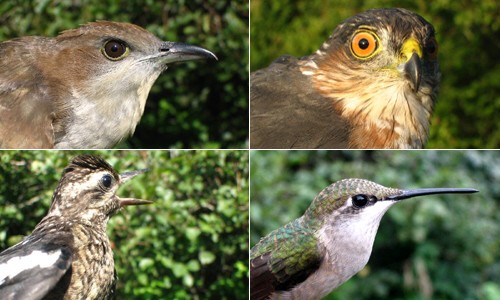|
McGILL BIRD OBSERVATORY |
||||||||||||||||||||||||||||||||||||||||||||||||||||||||||||||||||||||
Welcome
to the McGill Bird Observatory weekly report.
Click here for a complete listing of our archives.
Bander-in-charge:
Seabrooke Leckie Notes: The first week of fall 2006 got off to a rolling start on August 1. Although some effort was made in 2005 to obtain coverage in August, this is the first year at MBO in which there has been full coverage each week this month. A total of 150 birds were banded over the course of the week, averaging a fairly steady mid-twenties each day. The 1st and 2nd were especially hot and humid, so the total of 48 banded over the two days was somewhat surprising. Movement was restricted, for the most part, to the local breeders on the first day, although a post-breeding male Nashville Warbler was captured, who had dispersed to the site to complete his fall moult prior to departing for his wintering grounds. More migrants and post-breeding dispersal were seen on the 2nd, with an Ovenbird, an American Redstart and two White-throated Sparrows, both still in juvenal plumage. The morning of the 3rd dawned overcast and threatening rain, which reduced net hours to less than half of the normal total for the day. Only six birds were banded, and the site felt generally quiet all morning. A visiting ornithologist from Australia spent the morning volunteering with us, with the hope of seeing some new species - he had the misfortune of coming out on the quietest day all week, but we were still able to share some of our wonderful avifauna with him. Things picked up again the next day with the return of clear weather. Our first small movement of warblers was evident, both in the nets and on census. A total of 23 birds were banded, of which eleven were warblers. Three Tennessee Warblers were captured, all females, two of which were adults undergoing their prebasic moult. A Nashville Warbler and an Ovenbird, as well as an American Redstart on census, were among the others to move into the area. A cold front and north winds overnight produced another small influx of birds on the 5th. Expectations were high for the day when we captured 14 birds on the first round alone, however activity tapered off following that and we only caught another 15 all rest of the morning. Despite this, another two Tennesees, a redstart and an Ovenbird were banded, as well as two Veerys, still in their speckled juvenal plumage, most likely dispersed from nests in the forests of the Arboretum next door. On census, both Myrtle and Black-and-white Warblers made their first showing of the season. Song Sparrow numbers peaked with a DET of 40 in the area; many were concentrating around the fallen apple tree at the parking area, as well as in the mown grass surrounding the newly set-up J-trap. This suggests the trap may be quite successful once it's completely up and running. Our highest species count for the week was recorded on the 5th, with a total of 51 seen or banded. A similar pattern of capture was observed on the 6th, with a busy early couple of rounds tapering off later in the morning. One of the first captures of the day was of a third-year male Sharp-shinned Hawk, enticed perhaps by the warbler in the net (we report that his attempt was thwarted). An Eastern Kingbird and a Yellow-bellied Sapsucker were banded, both uncommon birds in the net, but the indisputable highlight of the day, and possibly the week, was a hatch-year Black-billed Cuckoo captured on one of the last rounds. This is an uncommon visitor to MBO, and represents the first banding record of the species at the station. Despite breezy conditions and patchy skies, the week wrapped up with our highest banding total of the period, with 29 new birds. Almost half of this total is due to a single flock of predominantly young Baltimore Orioles that flew into one net later in the morning. Another Ovenbird and the season's first Magnolia Warbler were also captured on earlier rounds. However, despite the banding total, little was observed moving around the area, as the birds remained mostly quiet all morning - it was just us, the crickets and the cicadas!
This week’s top 10 is substantially different from July’s, with many species banded in fairly large numbers as breeders begin migrating and young disperse or band together in large flocks. These flocks become evident when you look at the number of individuals observed daily – the Red-winged Blackbirds have rocketed from 18 to 120 individuals seen per day!
|



